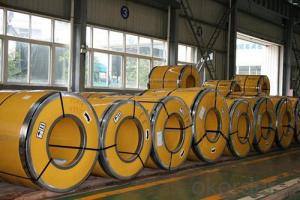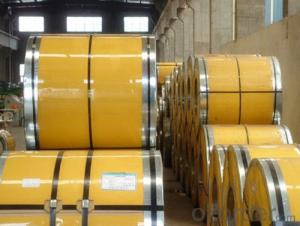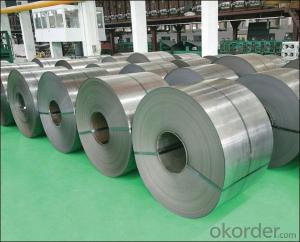Hot Rolled Stailess Steel Coil 300 Serious
- Loading Port:
- Tianjin
- Payment Terms:
- TT OR LC
- Min Order Qty:
- 25 m.t.
- Supply Capability:
- 100000 m.t./month
OKorder Service Pledge
OKorder Financial Service
You Might Also Like
Hot Rolled Stailess Steel Coil 300 Serious
1.Structure of Hot Rolled Stailess Steel Coil 300 Serious
Hot Rolled Stailess Steel Coil 300 Serious is one of the raw material of the cold rolled stainless steel strip, which can be used directly in many places. Stainless Steel (Stainless Steel) is short for acid-proof Stainless Steel, resistant to weak corrosive medium such as air, steam, water, or with a Stainless Steel grade.
2.Main Features of Hot Rolled Stailess Steel Coil 300 Serious
1) weldability: The purpose of the different requirement for welding performance are different.1 Kind of tableware generally do not require the performance of welding, even including some pot class enterprise. But the vast majority of products all need raw materials welding performance is good, like the 2 kinds of tableware, thermos flask, steel pipes, water heaters, water dispensers, etc.
2) Corrosion resistance The vast majority of stainless steel products for corrosion resistant performance is good, like a, 2 kinds of tableware, kitchen utensils and appliances, water heaters, water dispensers, etc., some foreign businessmen on corrosion resistance of products also do experiment: in NACL aqueous solution heated to boiling, after a period of time the best solution, wash and drying, weight loss, to determine the degree of corrosion (note: the product polishing, because of the sand cloth or sandpaper containing Fe, will cause the test surface rust spots)
3) Polishing performance In today's society stainless steel products in production after polishing the process commonly, when only a small number of products such as water heaters, water dispenser tank don't need polishing. So this will require materials polishing performance is very good. The factors influencing polishing performance mainly include the following: 1) raw material surface defects. Such as scratch, pitting, pickling, etc. (2) raw material problem. Hardness is too low, easy when polishing cast light (BQ), and the hardness is too low, the surface easily when deep drawing appear orange peel phenomenon, which affects the BQ. Relatively high hardness of BQ sex is good. (3) after deep drawing products, great deformation area surface will be a small black spots and RIDGING, thus affecting the BQ.
4) Heat resistant performance Heat resistant performance refers to the high temperature stainless steel can still maintain its excellent physical and mechanical properties. Carbon: the influence of carbon in austenitic stainless steel is formed strong and steady. Set the austenitic austenitic area and expand elements. Carbon formation of austenite is about 30 times that of the nickel, the ability of carbon is a kind of gap elements, through the solid solution strengthening can significantly increase the strength of the austenitic stainless steel. Carbon austenitic stainless steel can be improved in high concentration chloride (e.g., 42% MgCl2 boiling solution) in the performance of the resistance to stress corrosion. But, in the austenitic stainless steel, carbon is often seen as the harmful elements, this is mainly due to the corrosion of stainless steel used in some conditions, such as welding or heating by 450 ~ 850 ℃), carbon steel with chromium in forming high chromium Cr23C6 type carbon compounds which can lead to local chromium depletion, make steel corrosion resistance especially resistant to intergranular corrosion performance degradation. So. Since the 60 s of the development of new cr-ni austenitic stainless steel is mostly carbon content less than 0.03% or 0.02% of the ultra-low carbon type
5) Corrosion resistance When the atomic number of no less than 12.5% chromium content in steel, can make the steel electrode potential mutations, the negative potential to the positive electrode potential. To prevent electrochemical corrosion.
3. Hot Rolled Stailess Steel Coil 300 Serious Images
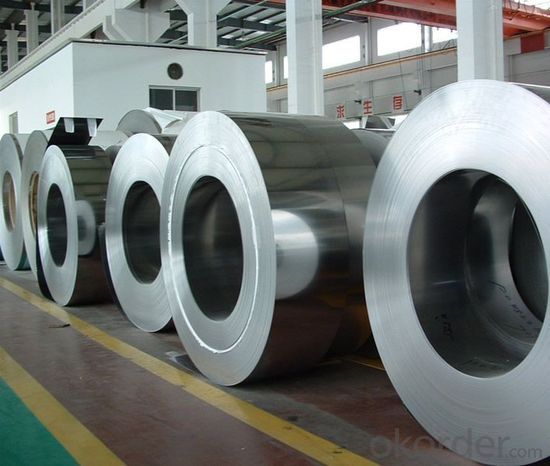
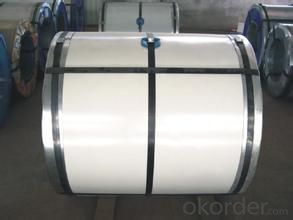
4. Hot Rolled Stailess Steel Coil 300 Serious Specification
The word "stainless steel" is not merely refers to a pure stainless steel, but said more than one hundred kinds of stainless steel industry, the development of each stainless steel has good performance in their specific applications. The key to the success of the first is to make clear purpose, and then determine the correct material. Related to architectural construction applications usually only six types of steel. They contain 17 ~ 22% chromium, good steel contains nickel. Add molybdenum can further improve the atmospheric corrosion resistance, especially containing chloride atmospheric corrosion resistance. Stainless steel often according to the state of organization can be divided into: martensite steel, ferritic steel, austenitic steel, austenitic (two-phase) - ferrite stainless steel and precipitation hardening stainless steel, etc. In addition, according to ingredients can be divided into: chromium stainless steel, chromium nickel stainless steel and chromium manganese nitrogen stainless steel, etc.
1) Ferritic stainless steel Chromium containing 15% ~ 30%. Its corrosion resistance, toughness and weldability with chromium content increases with the increase of chloride stress corrosion resistance is superior to other types of stainless steel, fall into this category of Crl7, Cr17Mo2Ti, Cr25, Cr25Mo3Ti, Cr28, etc. Ferritic stainless steel because of the high chromium content, corrosion resistance and oxidation resistance are relatively good, but the mechanical properties and process performance is poorer, more used to stress less acid structure and steel used as antioxidant. This kind of steel to withstand atmosphere, nitric acid and corrosion of the brine solution, and has good high temperature oxidation resistance, low thermal expansion coefficient, etc, used in nitric acid and food factory equipment, also can make work under high temperature parts, such as gas turbine parts, etc.
2) Austenitic stainless steel The title Chromium is more than 18%, still contain about 8% of the nickel and small amounts of molybdenum, titanium, nitrogen and other elements. Good comprehensive performance, corrosion resistant to a variety of media. Number of austenitic stainless steel is commonly used one cr18ni9, 0 cr19ni9, etc. In the Wc < 0.08% 0 cr19ni9 steel, steel grade is marked as "0". This class contains large amounts of Ni and Cr in steel, make steel in austenitic state at room temperature. This kind of steel has good plasticity and toughness, weldability and corrosion resistance and non-magnetic or weak magnetic, the corrosion resistance in oxidizing and reducing medium are good, used to make acid equipment, such as corrosion resistant containers and equipment lining, pipelines, nitric acid resistant equipment parts, etc., also can be used as the main body of watches and clocks jewelry stainless steel material. Austenitic stainless steel with solid solution treatment, the steel heating to 1050 ~ 1150 ℃, then water-cooled or air-cooled, for single-phase austenitic organization.
3) Austenitic, ferritic duplex stainless steel The advantages of both austenitic and ferritic stainless steel, and has the superplasticity. Austenite and ferrite The title Each accounts for about half of the stainless steel. In the case of contain low C, Cr content was 18% ~ 18%, Ni content at 3% ~ 3%. Some steel containing Mo, Cu, Si, Nb, Ti, N and other alloying elements. This kind of steel both austenite and ferrite stainless steel, the characteristics of compared with ferrite, plasticity and toughness is higher, no room temperature brittleness, intergranular corrosion resistance and welding performance were significantly increased, while maintaining a ferritic stainless steel of 475 ℃ brittleness and high thermal conductivity, has the characteristics of superplasticity. Compared with austenitic stainless steel, high strength and resistance to intergranular corrosion and resistance to chloride stress corrosion is improved obviously. Duplex stainless steel has excellent resistance to pitting corrosion performance, is also a kind of nickel and stainless steel.
4) Precipitation hardening stainless steel For austenitic or martensite structure matrix, and the number of precipitation hardening stainless steel commonly used such as 04 cr13ni8mo2al. It can pass the precipitation hardening (also known as the age hardening) dealing with the hard (strong) of stainless steel.
5) Precipitation hardening stainless steel For austenitic or martensite structure matrix, and the number of precipitation hardening stainless steel commonly used such as 04 cr13ni8mo2al. It can pass the precipitation hardening (also known as the age hardening) dealing with the hard (strong) of stainless steel.
5.FAQ of Hot Rolled Stailess Steel Coil 300 Serious
We have organized several common questions for our clients,may help you sincerely:
①How about your company?
A world class manufacturer & supplier of castings forging in carbon steel and alloy steel,is one of the large-scale professional investment casting production bases in China,consisting of both casting foundry forging and machining factory. Annually more than 8000 tons Precision casting and forging parts are exported to markets in Europe,
②How to guarantee the quality of the products?
We have established the international advanced quality management system,every link from raw material to final product we have strict quality test;We resolutely put an end to unqualified products flowing into the market. At the same time, we will provide necessary follow-up service assurance.
③What applications your products can have?
Kitchenware: tableware, cookware, Stoves…
Food packing: storage cans, food containers…
Construction: bridge, roofing, wall, decoration, bathroom accessories…
Precision instruments: electrical products, aerospace…
Others: automotive parts, machine building, chemical processing, farming…
- Q:What is the corrosion resistance of stainless steel strips in acidic environments?
- In acidic environments, stainless steel strips display exceptional resistance to corrosion. This is due to the abundant levels of chromium found in stainless steel, which create a protective oxide layer on the surface. This layer acts as a shield against corrosion by preventing direct contact between the metal and the acidic environment. Consequently, the risk of corrosion is greatly reduced. Furthermore, stainless steel is renowned for its ability to resist pitting and crevice corrosion, both of which are prevalent forms of corrosion in acidic environments. In summary, stainless steel strips are highly resistant to corrosion in acidic environments, making them a suitable choice for a range of applications in industries such as chemical processing, food processing, and pharmaceuticals where exposure to acidic substances is commonplace.
- Q:Are 111 stainless steel strips suitable for electrical conductivity applications?
- No, 111 stainless steel strips are not suitable for electrical conductivity applications.
- Q:What are the common uses of stainless steel strips in the pharmaceutical industry?
- Due to their unique properties, stainless steel strips find extensive use in the pharmaceutical industry. They are suitable for a variety of applications, and some common uses include: 1. Packaging: Stainless steel strips provide a safe and hygienic barrier, protecting pharmaceutical products like tablets, capsules, and powders from external contaminants, moisture, and light. 2. Sterilization containers: Stainless steel strips are vital in fabricating sterilization containers, which are essential for the sterilization process in pharmaceutical manufacturing. These containers effectively sterilize and maintain medical instruments, equipment, and supplies in a sterile condition. 3. Mixing and blending equipment: Stainless steel strips are used to construct mixing and blending equipment, such as containers, tanks, and vessels. These equipment ensure efficient and consistent mixing of ingredients in pharmaceutical formulations. 4. Conveyor systems: Stainless steel strips are commonly employed in constructing conveyor systems, extensively used in pharmaceutical manufacturing for transporting raw materials, intermediate products, and finished goods. The corrosion-resistant nature of stainless steel guarantees cleanliness and purity during the manufacturing process. 5. Cleanroom applications: Stainless steel strips are utilized in cleanrooms, critical to maintaining a controlled environment free from contaminants. They are used to fabricate cleanroom furniture, equipment, and fixtures, ensuring a hygienic and durable solution that withstands frequent cleaning and disinfection. 6. Equipment and machinery components: Stainless steel strips are employed in manufacturing various components for pharmaceutical equipment and machinery, such as pumps, valves, fittings, and connectors. The high strength, corrosion resistance, and ease of fabrication of stainless steel make it a preferred material in these applications. In summary, stainless steel strips are vital in the pharmaceutical industry due to their corrosion resistance, durability, cleanliness, and ease of maintenance. These properties make stainless steel strips an ideal choice for various applications, ensuring the safety, quality, and efficacy of pharmaceutical products.
- Q:Are stainless steel strips suitable for pharmaceutical equipment?
- Yes, stainless steel strips are suitable for pharmaceutical equipment. Stainless steel is a commonly used material in the pharmaceutical industry due to its excellent corrosion resistance, durability, and hygienic properties. It is easy to clean, resistant to bacteria growth, and can withstand high temperatures and harsh chemicals typically used in pharmaceutical processes. Stainless steel strips can be used for various applications in pharmaceutical equipment, including manufacturing vessels, storage tanks, mixing equipment, conveyors, and packaging machinery. The material's strength and reliability make it suitable for maintaining the integrity and cleanliness required in pharmaceutical facilities, ensuring product safety and quality.
- Q:Can stainless steel strips be used in musical instruments?
- Musical instruments can indeed utilize stainless steel strips. Stainless steel, a versatile and durable material, finds extensive use across multiple industries, including music. It boasts exceptional resistance to corrosion, high strength, and favorable mechanical properties, rendering it suitable for diverse musical instrument applications. Instruments such as guitars, pianos, drums, and other percussion instruments can incorporate stainless steel strips. For instance, stainless steel strips can serve as frets on guitars, delivering a smooth surface for the strings to facilitate clear and crisp sounds. Similarly, in pianos, they can function as keys or hammers, providing a consistent and reliable striking surface for the strings. Moreover, stainless steel strips can contribute to the construction of wind instruments. Brass instruments like trumpets or saxophones can incorporate stainless steel strips as reeds or valves. The corrosion resistance of stainless steel ensures durability and safeguards against moisture and saliva exposure during play, preventing deterioration. Overall, the utilization of stainless steel strips in musical instruments presents numerous advantages. They offer durability, corrosion resistance, and versatility, thereby ensuring optimal instrument performance and long-lasting quality.
- Q:How do stainless steel strips resist intergranular corrosion?
- Stainless steel strips resist intergranular corrosion due to their unique composition and microstructure. The main factor that prevents intergranular corrosion in stainless steel is the presence of chromium in the alloy. Chromium forms a protective oxide layer on the surface of stainless steel, known as a passive film, which acts as a barrier against corrosive elements. In stainless steel, the passive film forms spontaneously when the alloy is exposed to oxygen in the atmosphere. This film is very thin but highly stable and adherent, providing excellent resistance to corrosion. It prevents the diffusion of corrosive agents, such as oxygen and chloride ions, to the underlying metal. Additionally, stainless steel strips contain other alloying elements, such as nickel and molybdenum, which also contribute to the resistance against intergranular corrosion. These elements enhance the stability of the passive film and improve the overall corrosion resistance of stainless steel. Intergranular corrosion is specifically a concern along the grain boundaries of stainless steel, where chromium depletion can occur during certain manufacturing processes or exposure to high temperatures. To mitigate this risk, stainless steel strips are often heat treated or annealed to restore the chromium content and ensure a homogeneous microstructure throughout the material. This treatment helps to maintain the integrity of the passive film and prevents intergranular corrosion. Overall, the combination of chromium content, the formation of a stable passive film, and appropriate heat treatment make stainless steel strips highly resistant to intergranular corrosion, ensuring their durability and longevity in various applications.
- Q:What is the coefficient of thermal expansion of stainless steel strips?
- The coefficient of thermal expansion for stainless steel strips varies depending on the grade and composition of the alloy. When compared to other metals, stainless steel generally has a lower coefficient of thermal expansion. The coefficient of thermal expansion for most stainless steel alloys falls within the range of 10.8 to 16.5 × 10^-6 per °C (6.0 to 9.2 × 10^-6 per °F). This means that the stainless steel strip will expand by the specified coefficient for every degree Celsius increase in temperature. However, it is important to note that different stainless steel grades may have slightly different coefficients due to variations in their alloy composition. Therefore, it is crucial to refer to specific technical data to obtain the precise coefficient of thermal expansion for a particular grade of stainless steel.
- Q:Can stainless steel strips be used for magnetic applications?
- Stainless steel strips possess the capability of being utilized for magnetic purposes. Nevertheless, it is crucial to acknowledge that stainless steel, in its pure form, lacks magnetic properties. Usually, the magnetic characteristics of stainless steel strips are attained by incorporating additional elements like nickel or manganese into the alloy. These elements aid in constructing a magnetic framework within the stainless steel, enabling it to be magnetically attracted. Furthermore, it should be noted that the magnetic potency of stainless steel strips may fluctuate according to the precise composition of the alloy.
- Q:Are stainless steel strips suitable for use in corrosive environments?
- Stainless steel strips are a perfect choice for use in environments prone to corrosion. The exceptional corrosion resistance properties of stainless steel have earned it a well-deserved reputation as the ultimate material for situations where exposure to corrosive elements is expected. The presence of chromium in stainless steel creates a protective layer on the surface, referred to as the passive layer, which effectively shields the metal from reacting with the surrounding environment. This passive layer acts as a strong barrier against corrosive substances like moisture, acids, and salts, considerably minimizing the risk of corrosion. Furthermore, stainless steel strips can be further fortified with various alloying elements like molybdenum or nickel to boost their resistance against specific types of corrosion. This remarkable versatility ensures that stainless steel strips remain highly dependable and durable, even in the face of highly corrosive environments such as marine settings, chemical processing plants, or coastal regions.
- Q:What is the typical lead time for stainless steel strip production?
- The typical lead time for stainless steel strip production can vary depending on factors such as quantity, specifications, and the manufacturer's production capacity. However, it is generally expected to range from a few weeks to a couple of months.
1. Manufacturer Overview |
|
|---|---|
| Location | |
| Year Established | |
| Annual Output Value | |
| Main Markets | |
| Company Certifications | |
2. Manufacturer Certificates |
|
|---|---|
| a) Certification Name | |
| Range | |
| Reference | |
| Validity Period | |
3. Manufacturer Capability |
|
|---|---|
| a)Trade Capacity | |
| Nearest Port | |
| Export Percentage | |
| No.of Employees in Trade Department | |
| Language Spoken: | |
| b)Factory Information | |
| Factory Size: | |
| No. of Production Lines | |
| Contract Manufacturing | |
| Product Price Range | |
Send your message to us
Hot Rolled Stailess Steel Coil 300 Serious
- Loading Port:
- Tianjin
- Payment Terms:
- TT OR LC
- Min Order Qty:
- 25 m.t.
- Supply Capability:
- 100000 m.t./month
OKorder Service Pledge
OKorder Financial Service
Similar products
New products
Hot products
Hot Searches
Related keywords
